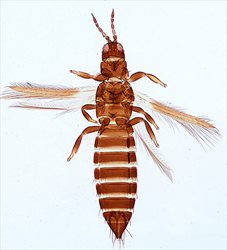
Female
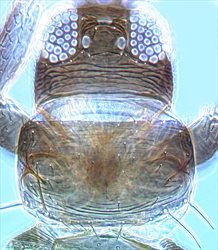
Head & pronotum

Antenna

Antenna

Meso & metanota
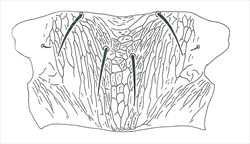
Metanotum
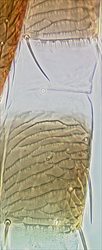
Pleurotergites

Abdominal tergite II
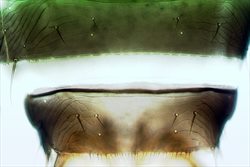
Tergites VII–VIII
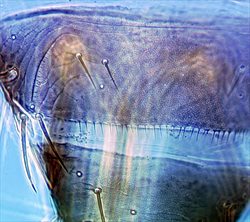
Tergite VIII
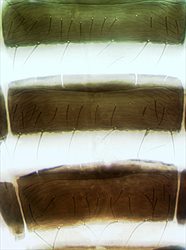
Sternites V–VII

Fore wing
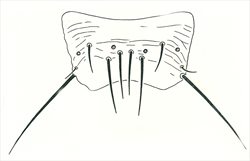
Male tergite IX
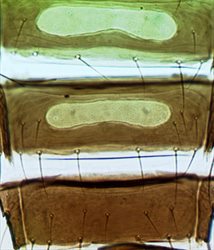
Male sternites V–VII
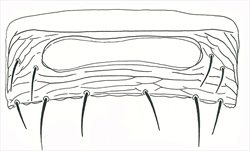
Male sternite V
Both sexes fully winged. Body and legs dark brown, tarsi and antennal segment III yellowish brown; fore wings brown, base paler. Antennae 8-segmented; III–IV with forked sense cone. Head with 2 pairs of ocellar setae; pair III small, arising just inside anterior margins of ocellar triangle; postocular setae pairs I & III slightly longer than ocellar setae III, postocular setae pair II minute. Pronotum with 2 pairs of posteroangular setae, outer pair slightly shorter than inner pair; posterior margin with 3–4 pairs of setae. Metanotum reticulate medially, reticles elongate on posterior half, most reticles with faint internal markings; median setae short, arising behind anterior margin; campaniform sensilla absent. Fore wing first vein with about 7 setae on distal half; second vein with about 14 setae. Abdominal tergite II with 3 lateral marginal setae; tergites V–VIII with paired ctenidia, on VIII posteromesad to spiracles; tergite VIII posteromarginal comb of microtrichia complete but slightly irregular; pleurotergites without discal setae, but bearing ciliate microtrichia. Sternite II with 2 pairs of marginal setae, III–VII with 3 pairs; sternite II with 1–2 discal setae, III–VII with about 12 discal setae in single row.
Male smaller than female; tergite VIII with no posteromarginal comb; sternites III–VII with large transverse pore plate, discal setae arising laterally.
The genus Thrips is the second largest genus in the Thysanoptera, and currently includes, worldwide, over 290 species. All members of genus Thrips lack ocellar setae I on the head, and they all have ctenidia on tergite VIII posteromesad to the spiracles. Other characters, such as number of antennal segments, number of setae on the fore wing veins, and number of discal setae on the sternites are variable between species (Palmer, 1992; Nakahara, 1994; Mound & Masumoto, 2005). Thrips simplex has discal setae on the abdominal sternites, and is usually easily recognized as it is the only species of Thrips in Britain with both 8-segmented antennae and markings on the metanotum between the main lines of reticulate sculpture.
Feeding and breeding in the flowers and on the leaves of its host plants, the Gladiolus Thrips is largely specific to Gladiolus species, but also breeds on other Iridaceae.
Originally from southern Africa, this species is locally common around the world wherever Gladiolus flowers are grown. Potentially it could be found on this host anywhere in Britain, as its distribution is connected to the commercial trade in Gladiolus cut flowers. It can breed outdoors in Britain (Morison, 1957), but there is little evidence available from which to evaluate its potential to overwinter outdoors. Similarly distributed across Europe and temperate areas around the world.
THRIPIDAE - THRIPINAE
Thrips simplex (Morison)
Physothrips simplex Morison, 1930: 12
Taeniothrips gladioli Moulton & Steinweden, 1931: 20
Physothrips plurisetae Girault, 1933: 2
Taeniothrips quinani Moulton, 1936: 506
Morison GD (1957) A review of British Glasshouse Thysanoptera. The Transactions of the Royal Entomological Society of London 109 (16): 467–534.
Mound LA & Masumoto M (2005) The genus Thrips (Thysanoptera, Thripidae) in Australia, New Caledonia and New Zealand. Zootaxa 1020: 1–64.
Nakahara S (1994) The genus Thrips Linnaeus (Thysanoptera: Thripidae) of the New World. United States Department of Agriculture. Technical Bulletin 1822: 1–183.
Palmer JM (1992) Thrips (Thysanoptera) from Pakistan to the Pacific: a review. Bulletin of the British Museum (Natural History) Entomology Series 61 (1): 1–76.